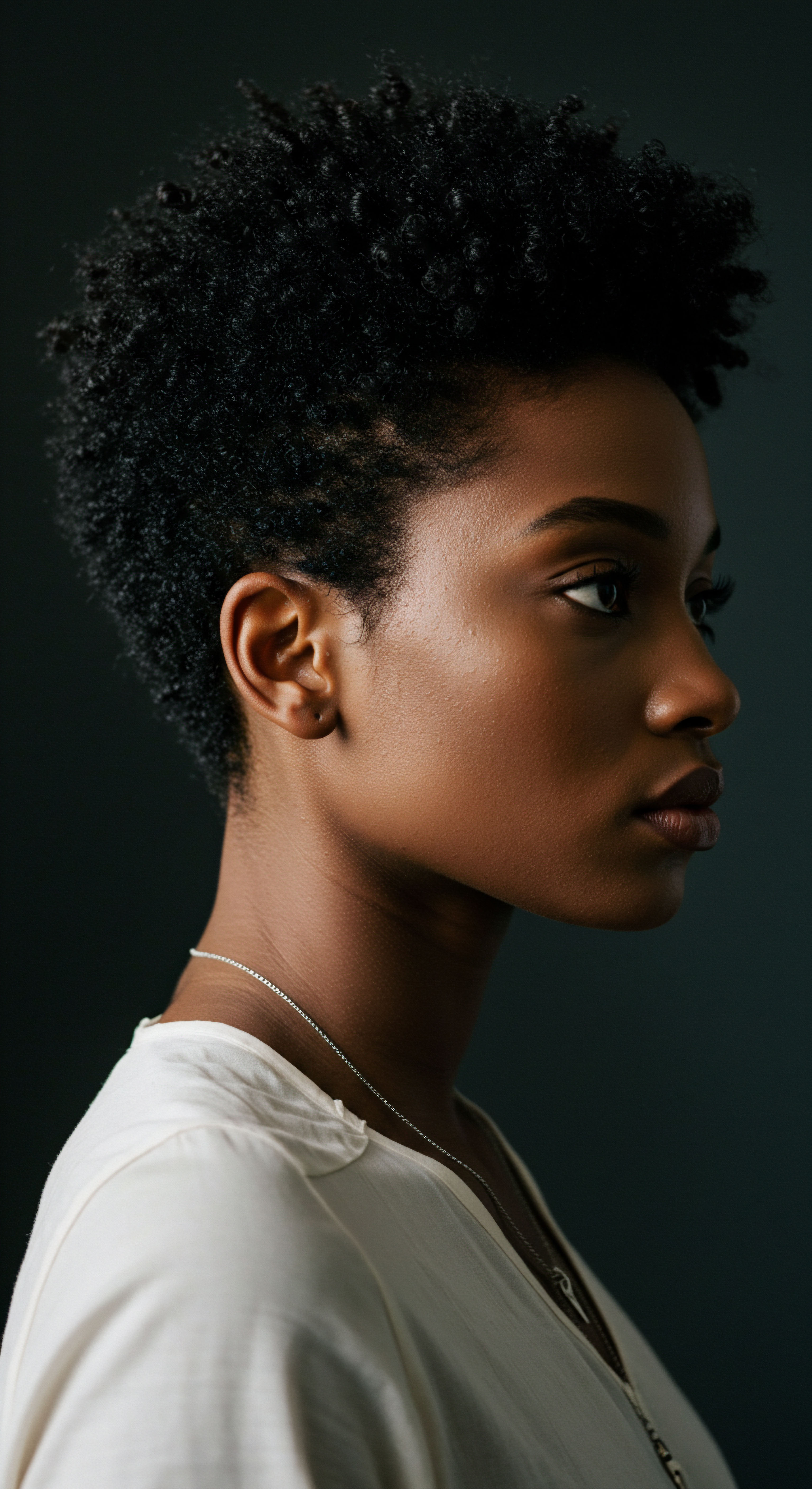
Roots
The gentle rhythm of life, often taken for granted, plays a silent yet profound role in the vitality of our hair. We speak of roots not only as the hidden anchor of each strand but as the very bedrock of our being, a connection to the elemental forces that shape us. Just as a plant draws sustenance from the earth, our hair, particularly textured hair with its unique spirals and coils, depends on an unseen wellspring of internal balance.
When this delicate equilibrium is disturbed, perhaps by the silent theft of sleep, the effects can ripple outward, touching even the deepest parts of our cellular architecture. The query of how sleep deprivation affects hair follicle stem cell activity invites us into a deeper conversation, one that transcends surface concerns and delves into the biological foundations of hair health.

The Architecture of a Strand
Each individual hair strand, whether a tightly coiled curl or a flowing wave, begins its existence within the confines of the Hair Follicle, a miniature organ nestled within the skin. This remarkable structure acts as a factory, tirelessly producing the keratinized cells that form the hair shaft. At the very base of this follicle lies the dermal papilla, a cluster of specialized mesenchymal cells that communicate with the epithelial cells above them. This constant dialogue orchestrates the hair growth cycle, guiding it through its distinct phases.

Hair Follicle Stem Cells and Their Role
Within the hair follicle, specific populations of stem cells reside, primarily in a region known as the bulge. These Hair Follicle Stem Cells (HFSCs) are the unsung heroes of hair regeneration. They possess the extraordinary capacity to self-renew and to give rise to all the various cell types that comprise the hair follicle, including those that form the hair shaft itself. When these stem cells are active, they propel the hair into its growth phase.
When they enter a state of quietude, the hair transitions into its resting phase. The rhythmic activity of these stem cells is fundamental to the continuous renewal of our hair.

The Circadian Connection to Hair Growth
Our bodies operate on an intricate internal clock, known as the Circadian Rhythm, a roughly 24-hour cycle that governs countless physiological processes, including sleep-wake patterns, hormone secretion, and even cell regeneration. Interestingly, hair follicles themselves possess their own peripheral circadian clocks, expressing core clock genes such as CLOCK and BMAL1. These internal follicular rhythms synchronize with the body’s central clock, influencing the timing and progression of the hair growth cycle.
The silent interplay between our body’s internal clock and the microscopic factories within our scalp determines the vitality of each hair strand.
During the crucial stages of hair growth initiation, particularly at the transition from the resting (telogen) phase to the early growth (anagen) phase, there is an increase in the expression of these circadian clock genes within the hair follicle. The secondary hair germ, which houses actively cycling stem and progenitor cells, exhibits the most prominent rhythmic circadian gene expression. This suggests a deeply embedded connection between our daily rhythms and the regenerative capacity of our hair.
When we consider the question of sleep deprivation, we are not simply looking at a lack of rest; we are peering into a disruption of this fundamental biological timing system. The delicate dance between rest and activity, governed by the circadian clock, directly influences the environment in which hair follicle stem cells operate, setting the stage for either robust growth or a gradual retreat.

Ritual
As we move from the unseen foundations of hair biology, our thoughts turn to the rhythms we consciously or unconsciously uphold in our daily lives. The routines we cultivate, the moments of pause we permit ourselves, and especially the sanctuary of sleep, are not mere incidental habits; they are rituals that profoundly shape our physical and emotional landscapes. When we ask how sleep deprivation affects hair follicle stem cell activity, we are also considering how the absence of this restorative ritual can ripple through our being, impacting the very wellspring of hair vitality. This section guides us through the practical wisdom of sleep’s influence, exploring how our nightly practices, or their absence, can subtly alter the terrain of our scalp and the vigor of our hair.

The Nightly Reset for Hair Follicles
Sleep, particularly its deeper stages, serves as a crucial period for the body’s repair and regeneration processes. This extends directly to the hair follicles, which undergo significant rejuvenation during these hours. It is during deep sleep that the body releases essential Growth Hormones, which are vital for stimulating cell regeneration and promoting hair follicle growth. Without adequate rest, the production of these hormones can be compromised, leading to slower hair growth or even stunted follicles.

Hormonal Synchronicity and Hair Health
Beyond growth hormone, other key hormones play a significant role in the hair growth cycle, and their balance is heavily influenced by sleep.
- Melatonin ❉ Primarily recognized for regulating sleep-wake cycles, melatonin also acts as a potent antioxidant and plays a role in hair health. It helps protect hair follicles from oxidative stress, which can damage cells and contribute to hair loss. Studies indicate that melatonin can promote hair growth by stimulating the proliferation of hair follicle cells and extending the anagen (growth) phase of the hair cycle. Hair follicles possess melatonin receptors, underscoring its direct influence.
- Cortisol ❉ This stress hormone, while necessary in appropriate amounts, becomes problematic when chronically elevated. Sleep deprivation is a significant trigger for increased cortisol levels. High cortisol can promote an inflammatory response and directly disrupt the hair growth cycle, potentially shortening the anagen phase and prematurely pushing follicles into the resting (telogen) phase.
The delicate dance between these hormones, orchestrated by healthy sleep patterns, ensures the hair follicles receive the appropriate signals for continuous, robust growth. When sleep is consistently disrupted, this hormonal symphony falls out of tune, creating an environment less conducive to vibrant hair.

Circulation and Nutrient Delivery
Sleep also influences blood circulation throughout the body, including the scalp. Hair follicles require a steady supply of oxygen and nutrients, delivered via the bloodstream, for optimal growth and function. Poor sleep can lead to restricted blood flow, limiting the delivery of these vital elements to the scalp and potentially resulting in weaker, slower-growing hair. The scalp, a highly vascularized area, relies on consistent blood flow to nourish its follicular inhabitants.
Restorative sleep provides the necessary biological canvas for hair’s vitality, ensuring hormonal balance and robust nutrient delivery to the scalp.
Consider the simple act of rest as a nightly ritual, a time when the body diligently works behind the scenes. Without this dedicated period of cellular repair and hormonal recalibration, the hair follicles find themselves in a state of subtle deprivation, struggling to maintain their natural rhythm and vigor. The cumulative effect of insufficient sleep becomes a quiet tax on the hair’s inherent ability to regenerate and flourish.

Relay
Stepping beyond the immediate impacts, we consider how the profound silence of sleep deprivation can echo through the intricate cellular conversations that sustain our hair. This section invites a deeper contemplation, a journey into the sophisticated mechanisms that govern hair follicle stem cell activity, drawing connections across biological systems and even subtle cultural nuances. The question of sleep’s absence becomes a lens through which we examine the delicate balance of regeneration, the whispers of stress hormones, and the very blueprint of our follicular resilience.

How Does Chronic Sleep Deprivation Affect Hair Follicle Stem Cell Quiescence?
The hair growth cycle is a meticulously orchestrated ballet of growth (anagen), regression (catagen), and rest (telogen). At the heart of this cycle lies the hair follicle stem cell (HFSC), which oscillates between states of active proliferation and a quiet, resting quiescence. Chronic sleep deprivation, a state of persistent physiological stress, can profoundly disrupt this delicate balance. Research indicates that persistent physiological stress can induce inactivity in HFSCs, thereby prolonging their resting phase and delaying the initiation of new hair growth.
A key player in this process is Cortisol, the human equivalent of corticosterone in rodents, a stress hormone produced by the adrenal glands. Under conditions of chronic stress, including that induced by sleep deprivation, cortisol levels become elevated. This elevated cortisol has been shown to have an indirect adverse effect on hair follicle stem cell activity.

The Cortisol-Gas6 Pathway and Hair Follicle Quiescence
Harvard Stem Cell Institute researchers, in a study published in Nature, shed light on a specific biological mechanism linking chronic stress to hair follicle stem cell behavior. They found that in a mouse model of chronic stress, hair follicle stem cells remained in an extended resting phase, failing to regenerate tissues. The stress hormone corticosterone (the mouse equivalent of human cortisol) was significantly upregulated, and administering this hormone to mice reproduced the stress effect on stem cells.
Chronic sleep disruption can push hair follicle stem cells into an extended resting phase, hindering the initiation of new hair growth.
Crucially, these researchers identified the specific cell type and molecule responsible for relaying this stress signal to the stem cells. They discovered that corticosterone acts on the Dermal Papillae to suppress the expression of a gene called Gas6 (growth arrest specific 6). Gas6 encodes a secreted factor that is essential for activating hair follicle stem cells. When hair follicle stem cells were exposed to Gas6, it prompted a rapid transition out of the resting phase and into regrowth.
This suggests that elevated cortisol, through its suppression of Gas6, keeps HFSCs in a prolonged state of dormancy, effectively putting a pause on hair regeneration. This research points to a fascinating, less commonly discussed pathway through which sleep deprivation, by elevating stress hormones, directly impacts the regenerative capacity of hair follicles at a molecular level.
| Mechanism Hormonal Imbalance (Cortisol) |
| Biological Impact Elevated stress hormones, inflammatory response |
| Hair Follicle Stem Cell Effect Prolongs quiescence, inhibits activation, shortens anagen |
| Mechanism Hormonal Imbalance (Melatonin) |
| Biological Impact Reduced antioxidant protection, altered signaling |
| Hair Follicle Stem Cell Effect May hinder proliferation, shorten anagen |
| Mechanism Disrupted Circadian Rhythm |
| Biological Impact Misaligned cellular processes, gene expression changes |
| Hair Follicle Stem Cell Effect Alters HFSC activation timing, affects cell cycle progression |
| Mechanism Reduced Blood Flow |
| Biological Impact Insufficient oxygen and nutrient delivery to scalp |
| Hair Follicle Stem Cell Effect Compromises HFSC environment, impairs function |
| Mechanism Increased Oxidative Stress |
| Biological Impact Accumulation of free radicals, cellular damage |
| Hair Follicle Stem Cell Effect Damages HFSCs, contributes to aging and dysfunction |

Inflammation and Oxidative Stress in the Follicular Niche
Beyond hormonal signaling, sleep deprivation contributes to a state of systemic inflammation and increased Oxidative Stress within the body. Oxidative stress arises from an imbalance between free radicals and the body’s ability to neutralize them, leading to cellular damage. Hair follicles are sensitive to this environment.
Increased levels of pro-inflammatory cytokines, such as TNF-α, which are heightened with lack of sleep, can directly impact the health of the scalp and potentially disrupt hair follicle function. This inflammatory state can contribute to conditions like telogen effluvium, where a large number of hairs prematurely enter the resting and shedding phases.
The cumulative effect of chronic sleep deprivation on the hair follicle environment is one of subtle yet persistent challenge. The stem cells, the very engines of hair regeneration, find themselves navigating a landscape altered by elevated stress hormones, diminished protective agents like melatonin, and a microenvironment tinged with inflammation and oxidative damage. This makes it more difficult for them to receive the proper signals to transition into active growth, leading to observable changes in hair density and overall vitality.
From a cultural standpoint, the relentless pace of modern life often celebrates productivity over rest, creating a societal narrative where sleep is seen as a luxury rather than a biological necessity. This overlooks the deep, interconnected ways in which adequate rest underpins not just our cognitive function, but the very cellular regeneration that maintains our hair. The science of sleep deprivation on hair follicle stem cells reminds us that our physical self, particularly our hair, carries the quiet imprint of our lifestyle choices.

Reflection
The journey through the intricate world of hair follicle stem cells and the subtle, yet profound, influence of sleep deprivation reveals a truth often overlooked in our hurried lives. Our hair, a visible expression of our vitality and heritage, whispers stories of our internal balance. It reminds us that true radiance stems not from surface applications alone, but from the deep, restorative currents that flow when we honor our body’s innate need for rest. As we continue to seek understanding and wellness, let us remember the quiet power of the night, a sacred space where the very roots of our being are tended, and the promise of renewal gently unfurls.

References
- Wang, H. Zhang, J. Yu, Z. & Chen, H. (2023). Hair Follicles as a Critical Model for Monitoring the Circadian Clock. Biology, 12(2), 200.
- Clinikally. (2024). Impact of Sleep Deprivation on Hair Health. Clinikally.com.
- Lau, J. (2021). How chronic stress leads to hair loss. Harvard Stem Cell Institute.
- Hair Doctors. (2025). Can Lack of Sleep Make You Lose Hair? Uncovering the Connection. Hair Doctors.
- Centre Clauderer. Hair and sleep ❉ the importance of the night for hair health. Centre Clauderer.
- Typology. (2024). The consequences of a lack of sleep on your hair. Typology.com.
- Northway Clinic. Examining the Relationship between Stress and Hair Loss. Northway Clinic.
- MONPURE. (2024). Hair Loss ❉ Is Lack of Sleep Stunting Growth? MONPURE.com.
- Treatment Rooms London. (2024). Can A Lack of Sleep Cause Hair Loss? Treatment Rooms London.
- Abbas, S. & Ahmad, N. (2016). Stress and the Hair Growth Cycle ❉ Cortisol-Induced Hair Growth Disruption. Journal of Drugs in Dermatology, 15(8), 1001-1004.
- DiStefano Hair Restoration Center. (2025). Does Sleep Affect Hair Health? DiStefano Hair Restoration Center.
- I2CAN. (2024). The Importance of Sleep for Skin and Hair Health. I2CAN.com.
- Trüeb, R. M. (2009). Oxidative stress in ageing of hair. International Journal of Trichology, 1(1), 6-14.
- LearnSkin. (2017). How Does the Circadian Rhythm Affect Hair Growth? LearnSkin.com.
- Mattress Depot USA. (2021). The Effects of Sleep Deprivation on Hair Health. Mattress Depot USA.
- Plikus, M. V. et al. (2010). Clock genes, hair growth and aging. ResearchGate.
- Laboratoires Bailleul International. Hair Loss and stress can be related. Laboratoires Bailleul International.
- Pearce, A. (2023). The stress – hair loss correlation. Anthony Pearce Trichology.
- Ms.Medicine. (2025). Beauty Sleep Guide ❉ How Sleep Affects Skin & Hair Health. Ms.Medicine.com.
- Mad Viking. (2024). How Sleep Deprivation Can Affect Your Hair Health. Mad Viking.
- Lau, J. (2021). Researchers discover how chronic stress leads to hair loss. Harvard Gazette.
- DUTCH Test Blog. Stress, Hair Loss, and Cortisol Connection. DUTCH Test Blog.
- Saatva. (2023). Does Sleep Really Matter for Hair Growth. Saatva.com.
- Verywell Health. (2025). Effects of Sleep Deprivation on the Body. Verywell Health.
- TrichoLab. (2023). Does Sleep Really Matter for Hair Growth. TrichoLab.com.
- Murad Skincare. (2023). Stressed? Anxious? Here’s how it’s affecting your hair. Murad Skincare.
- Dr Serkan Aygin Clinic. (2022). Do Your Sleeping Habits Affect Your Hair Loss? Dr Serkan Aygin Clinic.
- Reich, A. & Kwiecien, K. (2022). Circadian Rhythm and the Skin ❉ A Review of the Literature. Journal of Clinical and Aesthetic Dermatology, 15(7), 38-42.
- Han, H. et al. (2023). Melatonin Promotes the Development of Secondary Hair Follicles in Adult Cashmere Goats by Activating the Keap1-Nrf2 Signaling Pathway and Inhibiting the Inflammatory Transcription Factors NFκB and AP-1. Animals, 13(3), 488.
- Hsu, Y. C. et al. (2012). Corticosterone inhibits GAS6 to govern hair follicle stem-cell quiescence. Cell Stem Cell, 10(1), 63-75.
- Lin, K. K. et al. (2009). Circadian Clock Genes Contribute to the Regulation of Hair Follicle Cycling. PLoS Genetics, 5(11), e1000725.
- Gong, J. et al. (2023). Melatonin’s Role in Hair Follicle Growth and Development ❉ A Cashmere Goat Perspective. Cells, 12(11), 1493.
- Hims. (2024). Does Lack of Sleep Cause Hair Loss? Good Health by Hims.
- Guzik, T. J. & Touyz, R. M. (2022). Potential Role of Sleep Deficiency in Inducing Immune Dysfunction. International Journal of Molecular Sciences, 23(17), 9877.
- Babadjouni, A. et al. (2023). Melatonin and the Human Hair Follicle. Journal of Drugs in Dermatology, 22(3), 260-264.
- Wellbeing Nutrition. (2023). The Connection Between Sleep and Hair Loss. Wellbeing Nutrition.
- Babadjouni, A. et al. (2023). Melatonin and the Human Hair Follicle. PubMed.
- Hair Loss Daily. (2024). Melatonin for Hair Loss & Growth, Here’s Everything You Need to Know. Hair Loss Daily.
- Li, M. et al. (2023). Maternal Melatonin Contributes to Offspring Hair Follicle Development Through Transcriptional Regulation of the AP-1 Complex and MAPK Pathway. Animals, 13(10), 1640.
- Sokolov, A. et al. (2016). Signaling Involved in Hair Follicle Morphogenesis and Development. International Journal of Molecular Sciences, 17(11), 1888.
- Oshimori, N. & Fuchs, E. (2012). Paracrine TGF-β Signaling Counterbalances BMP-Mediated Repression in Hair Follicle Stem Cell Activation. Cell Stem Cell, 10(1), 63-75.
- MONPURE. (2024). Hair Loss ❉ Is Lack of Sleep Stunting Growth? MONPURE.com.
- Botchkarev, V. A. (2003). BMP signaling in the control of skin development and hair follicle growth. Experimental Dermatology, 12(6), 725-731.
- HairFree & HairGrow. (2023). Sleep and Hair Loss. Relationship Explained. HairFree & HairGrow.
- Altimus, C. M. et al. (2018). External light activates hair follicle stem cells through eyes via an ipRGC–SCN–sympathetic neural pathway. Proceedings of the National Academy of Sciences, 115(28), 7414-7419.